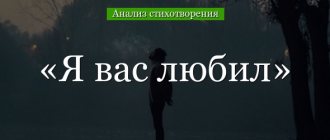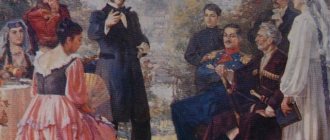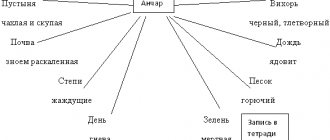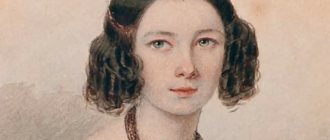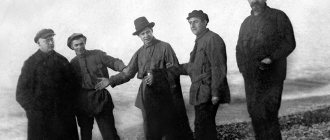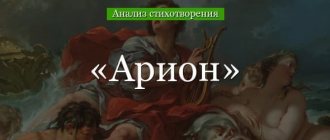History of creation
In 1825, Alexander Sergeevich Pushkin was again sent into exile by the emperor.
This time to Mikhailovskoye, a family estate on the mother’s side. Here the poet was bored at first, but then he got used to it and began to write, creating many talented works.
His nanny Arina Rodionovna was in exile with him. Many researchers believe that it was then that Alexander Sergeevich, inspired by her fairy tales, decided to write his own magical works for children.
The poem “Winter Evening” was born right there, in Mikhailovskoye, and it is dedicated precisely to the poet’s beloved nanny.
It is possible that it was on one of these evenings, when a blizzard was howling outside the window and it was snowing, that the great Russian writer came up with the idea to write an incredibly warm creation, saturated with love and quiet home comfort.
History of writing
Researchers provide brief abstracts about the time when the work “Winter Evening” was written. The year 1824 was the most difficult period in the life of Alexander Sergeevich Pushkin. The poet returned home after several years of southern exile, where he was sent for his freedom-loving political poems. But he was not allowed to live in St. Petersburg and Moscow.
The authorities sent Pushkin to the family estate Mikhailovskoye , where the poet's family lived. His parents, sister and brother Lev were there at that time. The fact that the poet was under surveillance spoiled his relationship with his father. The authorities suggested that Sergei Lvovich monitor his son’s correspondence and his social circle. The father read the poet's letters and controlled his every step. Because of this, quarrels constantly occurred. Relations with his father worsened even more when Alexander Sergeevich found out that he was trying to send him to prison.
Due to the difficult situation in the family, the poet was forced to stay for a long time with his friends on neighboring estates. But he had to coordinate each departure with the provincial authorities. By winter, the Pushkin family left for St. Petersburg, and the poet became more comfortable. But soon his friends also left, and the poet was left alone on the estate, with his nanny Arina Rodionovna. There he lived continuously throughout the winter of 1825. Then he wrote the poem “Winter Evening,” dedicated to the storm and communication with the old nanny. It was first published in 1830 in the almanac “Northern Flowers”, which was published by Pushkin’s lyceum friend Anton Delvig.
Composition
The composition, one might say, is circular. The work begins the same way it ends.
This feature is clearly expressed in the repeated verses:
The storm covers the sky with darkness, spinning snow whirlwinds; Then she will howl like a beast, then she will cry like a child.
It is with them that both the first and last stanzas of the work begin.
There are no pronounced compositional points (composition, resolution, etc.) here. The author simply reflects while the blizzard howls, emphasizing his gloomy, dreary mood.
Genre
The genre of the poem “Winter Evening” is realistic landscape lyricism. Although literary critics find elements of classicism and romanticism in this work.
Analysis of the poem by A.S. Pushkin shows that this work is a reflection of the poet’s life position. His perception of the world is conveyed using vivid images and expressive means.
The poem “Winter Evening” was written in Mikhailovsky, in exile. The disgraced poet was at this time away from friends who shared his thoughts and feelings. He was obliged to report his every step to the provincial authorities. The poet's days were busy with work and reading. The long and harsh winter was especially difficult. In snow-covered Mikhailovsky there was only one kindred spirit - nanny Arina Rodionovna.
On one of these winter evenings, Pushkin wrote a poem addressed to her. It begins with a very vivid and figurative description of a snow storm, which seems to cut off the poet from the entire outside world. This is exactly how Pushkin felt under house arrest. It’s easy to imagine the picture depicted in the poem: it’s a late winter evening, a blizzard is howling outside, and the stove flooded by the nanny is crackling in the room.
Compositionally, the poem can be divided into four parts (by stanzas):
The first part is entirely devoted to the blizzard
(or, as the author calls it, a storm). How many different shades the poet uses to describe it! He is not content with the usual words: “a blizzard howled,” he found vivid visual and auditory images. Here are his visual impressions: the sky is covered with darkness, a furious wind is swirling snow whirlwinds in the field. The author’s hearing distinguishes many shades: the howl of a wild animal (probably a wolf), the cry of a child, the rustling of a thatched roof, or the knocking on the window of a lost Traveler.
The entire first part is filled with various movements of the blizzard. This is achieved by using numerous verbs: the storm “covers the sky”, “spins whirlwinds”, “cries”, “howls”, “rustles the straw”, “knocks on the window”. In this part, the poet uses onomatopoeia: the howling of a blizzard is imitated by the frequently occurring sounds u, r: (storm, whirlwinds, beast). The emphasis in words falls mainly on the sounds a or o - this also perfectly conveys the howling of a blizzard.
The second and third parts of the poem are entirely addressed to the nanny
, to a “good friend”. The two of them are in a snow-covered house, their state of mind is very similar. Question: “Why are you, my old lady, / silent at the window? "- the lyrical hero could probably turn to himself. The poet expresses various assumptions why the nanny is sad: Or are you, my friend, tired of the howling of the storm, Or are you dozing under the buzz of Your spindle?
We see the confrontation between the external and internal worlds - the world of the raging elements and the world of the “dilapidated shack”. The image of a “ramshackle shack” or “hut” was traditional for Russian poetry of the 19th and early 20th centuries. In Pushkin's work, the image of the house is unusually significant. A home for a poet is a place where the lyrical hero is protected from all blows of fate and any adversity.
The outside world is dark and cold, there is a lot of disharmony in it: the storm cries and howls like an animal, probably trying to get into the house. Maybe a storm is not only a natural phenomenon? Perhaps the daring and angry whirling of a snowstorm outside the window is an image of fate dooming the poet to loneliness? But it is not in Pushkin’s character to indulge in sadness. And although the house is just a “dilapidated shack,” there is a way to survive and not lose heart: Let’s drink, good friend of my poor youth, Let’s drink out of grief; where is the mug? The heart will be more cheerful.
The poem was written by Alexander Sergeevich Pushkin in exile, far from his friends on a late winter evening. Loneliness and lack of freedom oppressed the poet. The only relative with him was his nanny. He spent all his days reading and working.
The author addresses Arina Radionovna. At the beginning, a winter blizzard is described that locks the heroes in the house. This is exactly how the poet felt in exile. The work is divided into several parts. The first part consists of a description of the movement of the blizzard.
Pushkin uses many vivid images. He describes the blizzard not only visually, but also using auditory images. The howl of an animal, the cry of a child, the knock of a traveler, the rustling of a roof are heard by the author. In the second and third parts, the author addresses the nanny. The poet is sad with her and looks for the reasons for this sadness. The outside world of the dilapidated shack is contrasted with the inside. The elements are raging outside the window, and a warm stove is crackling in the shack. Home is a place where the author feels protected.
In the fourth part, the world of the dilapidated house turns out to be stronger than the world of the blizzard. The poet uses epithets, similes, metaphors and personification to convey this. The poem is written in trochaic tetrameter with cross rhyme.
Artistic originality of the work
In creating the work, the author used an interesting technique: psychological parallelism.
Describing the storm outside the window, he emphasized his own depressed state. Everything around is sad, as is the soul of the lyrical hero. However, a conversation with the old nanny slightly dispels the melancholy and distracts from heavy thoughts.
This is the main message of the poem: no matter what storms rage around, it is important to have a close, understanding person nearby, to whom you can open your heart.
Consequences of royal wrath
The nobles were supposed to be the support of the autocracy. For faithful service there was a reward from the emperor, but if anyone went wrong, he received what he deserved in accordance with the will of the almighty Tsar-Father.
First, southern link
The punishment was quite mild. For epigrams on political figures and works containing criticism of autocracy and serfdom , Pushkin was sent to Chisinau, where he was formally listed as a clerical employee and reported to the main trustee of the colonists of the Southern Territory . In fact, the poet, who was 21 years old, was not particularly burdened with work and moved freely throughout the south from Chisinau to the Caucasus.
However, after moving to Odessa, everything changed. Service under Count Vorontsov turned out to be completely different. Conflicts arose, not only official ones, but also personal ones. Due to the current circumstances, in 1823 Pushkin even submitted his resignation. The forced southern assignment was ending, essentially the first exile.
Second punishment, more severe
The year was 1824, the poet was 25. Of course, in his dreams the exile already saw himself among friends or in social salons. However, everything changed the emperor’s decision:
- residence in both capitals is prohibited;
- deprived of his salary (and it was very modest);
- send Alexander Pushkin to the village of Mikhailovskoye for an indefinite period of supervision.
In vain did the imagination helpfully remind the disgraced poet of the magnificent balls of the Northern capital and Moscow, communication with friends. After the censorship discovered a confession written in Pushkin’s own hand in a message to Kuchelbecker, the anger of Alexander I fell upon him with renewed vigor: the poet did not draw the proper conclusions, he was still carried away by atheistic ideas and teachings!
This time the punishment was severe and even to some extent Jesuitical:
- Even going to neighboring estates to see friends is possible only with the permission of the provincial authorities.
- Correspondence was monitored, as was the social circle.
- The authorities entrusted the supervision of the disgraced poet to none other than his father, Sergei Lvovich Pushkin.
Not only were they exiled, but they also tried to upset my relationship with my family as much as possible. But when Alexander received information about the parent’s intention to put his own son behind bars, the situation escalated incredibly, and only God knows what this could lead to.
Season of sadness and loneliness
Fortunately, winter was already approaching, and the family drove off to the capital. Pushkin felt better.
Only here’s the problem: with the approach of winter, the neighboring landowners, like migratory birds, flocked to Moscow and St. Petersburg. There was no one to visit the poet.
All that was left was to take walks alone through empty groves and fields. Well, if the bad weather clears up, you can probably read. It is impossible to write on command; inspiration comes when it pleases.
True, there is one more outlet in the dreary string of days: next to Pushkin is a woman who for him was the personification of kindness. She was not his mother, but she loved and cared for Alexander from the time he was still a baby. Unloved by his own mother, the child found warmth and tenderness in the serf Arina, who was taken into the master's house as a nanny. Years have passed, but the grown-up pupil is still attached to this gray-haired old woman.
When Sasha felt bad, as a child he ran to her. Now he feels bad too. And she becomes for the twenty-five-year-old poet not only a source of folk songs, fairy tales and legends, but also a comforter. Long conversations accompanied by a blizzard or downpour gave peace to the rebellious soul. And it doesn’t matter at all that these two people belonged to different classes: one was a landowner, the other was a serf peasant woman.
Pushkin described one of many similar episodes in the poem “Winter Evening.” Illustrations for the work can be easily imagined:
- A snow-covered hut is barely visible through the blizzard; a candle light flickers in a window covered with frosty drawings.
- Inside it is twilight, the modest decoration of the nanny’s home is barely visible. The light illuminates only Arina Rodionovna and Pushkin at the table. The woman is spinning, and the poet, leaning on his elbows, watches her.
Size, rhyme and stanza
The text consists of four eight-line lines, with the first and fourth beginning with the same lines, which only enhances the feeling of melancholy and sadness, because the mood of the lyrical hero does not improve, although it becomes a little easier.
The work is written in trochaic tetrameter - a meter more suitable for folk ditties than elegies. Why Pushkin chose this particular form is unclear. Perhaps the trochee encouraged the poet and put him in an optimistic mood.
cross type rhyme .
Analysis of "Winter Evening"
The poem is an excellent example of landscape lyricism. It contains both romanticism and realism.
Features of Pushkin's essay
The mood of the lyrical hero is felt from the first lines. It is shown through a description of nature.
This work belongs to different genres at the same time. Quite justifiably these wonderful verses can be called:
- elegy - the hero is sad and nostalgic;
- message - the second half of the text is a direct appeal to the nanny.
Four stanzas make up this work, written in trochaic tetrameter. Each is formed in eight lines. Cross rhyme (ABAB). In principle, using a trochee to write an ode is a rather bold decision: this meter is more commonly perceived in ditties.
The theme of the first octave was bad weather, a blizzard that was raging outside the window. The second and third are a description of the cozy, albeit poor, home of Pushkin’s nanny. Peace and love reign in it, it is these feelings that attract the poet here.
The very last, fourth stanza consists of two repetitions, which only enhance the psychological effect. Because of this feature, we can talk about a ring composition.
The description of the raging storm and the appeal to Arina Rodionovna is like a request for help addressed to the closest person who is always nearby. This is the main idea: it is very difficult to withstand adversity alone; it is important to be able to open up and receive support from someone, even if only moral.
Artistic means and techniques
Psychological parallelism is an interesting technique. In describing the winter weather, the poet notes that the raging storm even covered the sky with darkness. The power of the elements is such that everything is subject to it: snow whirlwinds and violent winds. It seems that the nature around is depressed and sad. This all emphasizes the emotional state of the exiled poet.
Alexander Sergeevich had an excellent command of the richness of the Russian language and very effectively used many artistic means. There are many of them in Pushkin’s poem “Winter Evening”:
- epithets;
- metaphors:
- comparisons;
- onomatopoeia;
- personifications.
The whirlwind howling outside the window is contrasted with the quiet and cozy little room - this is the antithesis. Anaphoras help you immerse yourself in the situation and even feel the emotions of the characters in the poem. It is noteworthy that in addressing the nanny, Pushkin uses a very demonstrative technique: he asks rhetorical questions, and, in fact, does not even expect an answer from his old lady. While this is a one-sided conversation, the nanny is only a silent participant in it. Perhaps, after the poet’s monologue, she will begin to sing something or tell a story from her youth.
The melody, special tonality and expressiveness of the poem have repeatedly attracted musicians. There are 45 known melodies written by composers of different eras: Alyabyev, Dargomyzhsky, Sviridov and others. However, the most popular is the romance of Pushkin's lyceum friend, Mikhail Yakovlev, written in 1832.
This small work contains a great truth. No matter how difficult fate may seem, love will help you overcome difficulties. She will save and give strength. This is why it is so important to treat like-minded people and family with care. To those who will support you in difficult times and help bring peace to your troubled soul and restore hope.
Means of artistic expression
In addition to the most interesting technique of psychological parallelism, the great poet used a variety of means of artistic expression.
There are a lot of comparisons and personifications here: “like a beast howls”, “cries like a child”, “like a belated traveler knocks on our window”, “a storm covers the sky with darkness”, “a dilapidated shack... sad”).
There are epithets (“good friend”, “snow whirlwinds”, “dilapidated shack”), metaphors (“girlfriend of my poor youth”, “the buzz of her spindle”).
(anaphora) is used many times
Then she will howl like an animal, Then she will cry like a child, Then she will suddenly rustle with straw on the dilapidated roof, Then, like a belated traveler, she will knock on our window. Or again: Are you, my friend, tired of the howling of the storm, or are you dozing under the buzz of Your spindle?
The presence of anaphors fascinates, completely immerses you in the atmosphere of what is happening, makes you feel the emotions and state of the author.
In addition to the already listed means of expressiveness, the poet uses rhetorical questions when addressing the nanny. He does not expect answers to them, he simply conducts a one-sided conversation.
Essay on the topic of my favorite poem by Pushkin: winter evening
Analysis of the poem 1. The history of the creation of the work. 2. Characteristics of a work of the lyrical genre (type of lyrics, artistic method, genre). 3. Analysis of the content of the work (analysis of the plot, characteristics of the lyrical hero, motives and tonality). 4. Features of the composition of the work. 5. Analysis of means of artistic expression and versification (presence of tropes and stylistic figures, rhythm, meter, rhyme, stanza). 6. The meaning of the poem for the poet’s entire work. The poem “Winter Evening” was written by A.S. Pushkin in 1825. In it, the poet conveys his impressions of his stay in Mikhailovskoye, where he was sent after the southern exile. Arriving in Mikhailovskoye in 1824, the poet found his whole family there. However, the proximity of relatives only worsened the situation. Pushkin’s relationship with his father was always strained, and then completely deteriorated, because Sergei Lvovich agreed to take on “official supervision” of his “unreliable” son, his correspondence and behavior. Soon the poet found out about this, and there was a major quarrel with his father, after which he even temporarily moved to his neighbors Osipov, in the village of Trigorskoye. In despair, Pushkin writes to V.A. Zhukovsky: “My dear, I’m running to you. Judge my situation... My father, taking advantage of the absence of witnesses, runs out and announces to the whole house that I beat him, wanted to, swung, could have killed him... I’m not making excuses before you. But what did he want for me with his criminal charges? Siberian mines and deprivation of honor? Save me, even with the fortress, even with the Solovetsky Monastery...” [20 – Davydov S.I., Severinenko Yu.D. Russian literature. M., 1965, p. 103.] And only in late autumn, when the poet’s family left Mikhailovskoye, did he breathe more freely. During this period, the poet rethinks life values, thinks about the meaning of life, about his own destiny. These motives are reflected in the poem “Winter Evening”. The work was first published as part of A.A.’s almanac. Delvig “Northern Flowers” for 1830 (published at the end of 1829). And a few months later, a parody of this poem with exactly the same name appeared in the Moscow Telegraph magazine - “Winter Evening”, the bored hero of which asks his uncle to entertain him by singing folk songs. The poem belongs to realistic landscape lyrics. However, researchers sometimes note the presence of classical and romantic style elements in the work. So, from classicism we have here a certain orderliness - clarity and clarity of images. The romantic stylistic element is the ambiguity of these images, the musicality of the work. The poem opens with a picture of the raging winter elements: A storm covers the sky with darkness, Whirling snow whirlwinds... Storm, haze, snow whirlwinds - all this creates the image of a gloomy winter night. This whole picture is imbued with movement. The tetrameter trochee perfectly conveys the rhythm of the poem. However, this is not just a movement, but a whirlwind, a whirling, indicated both in visual and sound images: Then she will howl like an animal, Then she will cry like a child, Then she will suddenly rustle across the dilapidated roof, Like a belated traveler, To there will be a knock on our window. We find similar images of a winter whirlwind and aimless whirling in the poem “Demons”, in the stories “Blizzard” and “The Captain’s Daughter”. It is typical that the heroes of these works go astray. In “Winter Evening,” the hero is sheltered by a house, a “dilapidated shack.” This image appears already in the second stanza: Our dilapidated shack is both sad and dark, Why are you, my old lady, silent at the window? And here we see the confrontation between the external and internal worlds - the world of the raging elements and the world of the House, the “dilapidated shack.” This image of a “decrepit shack”, “hut”, going back to ancient lyric poetry, was traditional for Russian poetry of the 18th – early 19th centuries. In general, the image of the House has always been extremely important for the poet’s work. For Pushkin, home is a “native ashes,” a place where a person is protected from enemies, blows of fate, and life’s adversities. In addition, the image of the House is associated in the poet’s mind with the independence of man, with his spiritual freedom. Pushkin brilliantly expressed this thought in the poem “Two feelings are wonderfully close to us”: Two feelings are wonderfully close to us - In them the heart finds food - Love for the native ashes, Love for the tombs of our fathers. From time immemorial, by the will of God himself, the independence of man and all his greatness have been based on them. That is why this confrontation between Home and the outside world is so strong in the poem. The outside world is dark, cold, scary. Dark colors and sharp, disharmonious sounds dominate there: the storm cries, howls like a beast. She is trying to enter the House and disturb the peace of its inhabitants. And here we have various associations: a storm is not only a natural phenomenon, but also everyday adversity, blows of fate. The house is a reliable shelter from adversity. However, Pushkin’s House is a “dilapidated shack” that is “sad and dark.” Its inhabitants are sad and sad. A winter evening here means sudden silence (“you fell silent at the window”), and drowsiness (“you are dozing under the buzz of your spindle”), and weariness from life (“you, my friend, are tired”) [21 – See: Teplyakova D "Two "Winter Evenings". – Newspaper “Literature”, 2008, No. 3. Electronic version. lit.1september.ru]. These sensations bring the lyrical hero of “Winter Evening” closer to the hero of the poem “Winter Road”: It’s sad, Nina: my path is boring, My driver has fallen silent from his slumber, The bell is monotonous, The moon’s face is foggy. The winter night here gives rise to in the hero not fear, but sadness and a vague, unclear languor, unclear melancholy, inexplicable anxiety [22 – Ibid.]. We see the same thing in the poem “Winter Evening”. And here the motifs of light and darkness, always so important for Pushkin’s work, acquire special significance. Light and darkness symbolize good and evil in the poet’s work, and the struggle of these two principles looks like a victory of light over darkness. However, in “Winter Evening,” darkness clearly prevails over light, predicting victory for the forces of evil: the shack is “sad and dark.” Lyrically, the hero seems to be gradually preparing us for the development of another motive. The motive of fate clearly sounds here, embodied in the “buzz of the spindle”: Why are you, my old lady, silent at the window? Or are you, my friend, tired of the howling of the storm, or are you dozing under the buzz of Your spindle? In this case, the theme of fate, which can spin a person like a snow whirlwind, also seems very significant in Pushkin’s poem. But how can we resist this senseless whirling? The lyrical hero is trying to overcome, drown out his gloomy mood, a state of languid melancholy: Let's drink, good friend of my poor youth, Let's drink out of grief; where is the mug? The heart will be more cheerful. Sing me a song about how the tit lived quietly across the sea; Sing me a song like the girl went for water in the morning. Joy and fun take on a special meaning here. This is a means to survive and not lose heart in a difficult situation. It is not the house, but one’s own spiritual fortitude, creativity and harmony, peace in the soul that protect the lyrical hero from life’s adversities. Compositionally, we can distinguish four parts in the poem (post-strophe). The first part develops the theme of the storm, the senseless whirling. This is a world of Chaos and darkness. The second part creates the image of the House. The theme of fate is also heard here. Pushkin's fate is likened to the meaningless whirling of a blizzard. The third part denotes the lyrical hero’s desire to resist fate,” “a meaningless whirlwind.” In the fourth part, the images of the storm and the House are combined into one whole. However, the world of the House and the mental fortitude of its inhabitants turn out to be stronger than the world of Chaos. The poem ends with the motif of a feast, the image of a home [23 – Teplyakova D. “Two “Winter Evenings”. – Newspaper “Literature”, 2008, No. 3. Electronic version. lit.1september.ru]. The poem is written in trochaic tetrameter, octagonal, cross rhyme. Pushkin uses various means of artistic expression. The poet uses emotional epithets (“good girlfriend”, “poor youth”), figurative comparisons and personification metaphors: A storm covers the sky with darkness, Whirling snow whirlwinds, Then she will howl like an animal, Then she will cry like a child... The poem uses onomatopoeia . The howling of a blizzard in the first verses is imitated by the frequently occurring sounds “u” and “r” (“storm”, “twisting”, whirlwinds”, “beast”). “Winter Evening” marked the beginning of a whole series of deep, philosophical reflections of the poet about his life, fate, and the world around him. We are talking here about the poems “Winter Road”, “Demons”, “Poems Composed at Night During Insomnia”. This cycle is united by the poet’s restless thoughts and the painful search for meaning and harmony in life.

